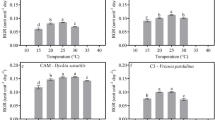Abstract
Ranunculus kadzusensis is an endangered aquatic plant species that commonly reproduces in the rice paddies of Korea and Japan during winter and early spring. Here, we investigated the effects of main aquatic environmental factors—light, temperature, and water depth—on its growth, with the goal of seeking information that will contribute to its in situ conservation. As the amount of shading increased, biomass, maximum shoot length, number of branches, flowers, and fruits, main stem diameter, and maximum leaf length decreased. Although seed germination occurred under a 12-h photoperiod and at either 30/20°C (day/night) or 20/15°C, most plants died at the higher temperature. Survival was 0% for surface-grown plant sets when tested in a wintertime pond experiment. The rate of maximum shoot extension was greatest for plants grown at depths of 50 and 100 cm versus those at 20 cm. Thus, we demonstrated that R. kadzusensis is intolerant of high temperatures and shade, which may explain why its growth is limited to paddies with no shading and where temperatures are low early in the year, before rice cultivation begins.




Similar content being viewed by others
References
Barko JW, Smart RM (1981) Comparative influences of light and temperature on the growth and metabolism of selected submersed freshwater macrophytes. Ecol Monogr 51:219–236
Barko JW, Adams MS, Clesceri NL (1986) Environmental factors and their consideration in the management of submersed aquatic vegetation: a review. J Aquat Plant Manag 24:1–10
Benvenuti S, Macchia M, Miele S (2001) Light, temperature and burial depth effects on Rumex obtusifolius seed germination and emergence. Weed Res 41:177–186
Garbey C, Thiébaut G, Muller S (2006) An experimental study of the plastic responses of Ranunculus peltatus Schrank to four environmental parameters. Hydrobiologia 570:41–46
Hunt R, Causton DR, Shipley B, Askew AP (2002) A modern tool for classical plant growth analysis. Ann Bot 90:485–488
Ku YB, Oh HK, Lee JH, Kong HY, Kil JH, Cho KH (2007) Distribution and genetic uniformity of an endangered aquatic plant, Ranunculus kadzusensis, in a South Korean rice paddy. Weed Biol Manag 7:120–123
Lee HW, Choung HL, Ro TH, Kwon YH, Kim CH, Hyun JO, Chang IS (2005). Categorization and conservation of the threatened plant species in environmental impact assessment. Korea Environment Institute
Maberly SC, Madsen TV (2002) Freshwater angiosperm carbon concentrating mechanisms: processes and patterns. Func Plant Biol 29:393–405
Madsen TV, Brix H (1997) Growth, photosynthesis and acclimation by two submerged macrophytes in relation to temperature. Oecologia 110:320–327
Middelboe AL, Markager S (1997) Depth limits and minimum light requirements of freshwater macrophytes. Freshwater Biol 37:553–568
Ministry of Environment of Korea (2007) 2007 Environmental Statistics Yearbook
Oitaken Seikatsukankyobu (2001) Red data book, endangered wildlives in Oita Prefecture. Oita, Japan. p. 174
Ren J, Tao L, Liu XM (2002) Effect of sand burial depth on seed germination and seedling emergence of Calligonum L. species. J Arid Environ 51:603–611
SAS Institute Inc (2006) SAS Enterprise Guide 4.1 software. SAS Institute Inc., Cary, NC, USA
Strand JA, Weisner SEB (2001) Morphological plastic responses to water depth and wave exposure in an aquatic plant (Myriophyllum spicatum). J Ecol 89:166–175
Suh MH, Koh KS, Ku YB, Kil JH, Oh HK, Suh SU, Rhee DG, Hyun JO, Shin HC, Koh JG (2002) Research on the conservation strategy for the endangered and reserved plants based on the ecological and genetic characteristics (II). Rep NIER 24:103–119
Tobiessen P, Snow PD (1984) Temperature and light effects on the growth of Potamogeton crispus in Collins Lake, New York State. Can J Bot 62(12):2822–2826
Trevors JT (1996) Sterilization and inhibition of microbial activity in soil. J Microbiol Meth 26:53–59
Wetzel R (1988) Water as an environment for plant life. In: Symoens JJ (ed) Vegetation of Inland Waters. Kluwer Academic Publishers, Boston, pp 1–30
Acknowledgments
This study was supported by the National Trust of Korea (3344-20070045) and a Brain Korea 21 Research Scholarship from the Korea Research Foundation.
Author information
Authors and Affiliations
Corresponding author
Rights and permissions
About this article
Cite this article
Jo, I.S., Han, D.U., Cho, Y.J. et al. Effects of Light, Temperature, and Water Depth on Growth of a Rare Aquatic Plant, Ranunculus kadzusensis . J. Plant Biol. 53, 88–93 (2010). https://doi.org/10.1007/s12374-009-9092-0
Received:
Revised:
Accepted:
Published:
Issue Date:
DOI: https://doi.org/10.1007/s12374-009-9092-0




